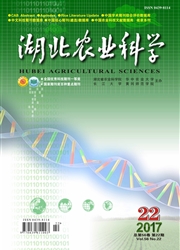

 中文摘要:
中文摘要:
基于生态足迹模型分析了湖北省1991-2011年耕地生态足迹、生态承载力及生态赤字,并且使用ArcGIS软件分析了2011年湖北省17个市(州)耕地生态足迹的空间分异规律,在此基础上,基于生态可持续指数(ESI)对湖北省耕地利用状况进行了评价。结果表明,湖北省耕地生态足迹不断增加,而生态承载力逐年下降,耕地的生态赤字呈波动增大趋势,全省耕地属于弱不可持续类型;湖北省耕地生态足迹可持续状况的空间分异表现在东西两端好于中部,神农架林区和恩施自治州生态盈余分别为0.289 0 hm2/人和0.096 0 hm2/人,耕地属于强可持续和弱可持续类型;西部的宜昌和十堰,东部的黄石和咸宁都较好;中部地区的荆门、天门、仙桃生态赤字最大,分别为0.652 0 hm2/人、0.492 hm2/人和0.486 hm2/人,而荆门和仙桃属于强不可持续类型。因此,运用生态足迹模型分析与评价耕地的利用状况具有广阔的应用前景。
 英文摘要:
英文摘要:
Based on the ecological footprint model and dynamic characteristics, the ecological footprint, ecological carrying capacity and ecological deficits of arable land in Hubei province(1991-2011) were analysed. Spatial variation regulars of ecological footprint of arable land in Hubei province(17 cities) in 2011 were stedied using the ARCGIS software. Pased on ecological sustainable index(ESI), utilization status of cropland in Hubei province was evaluated. The results showed that ecological footprint per capita of cropland in Hubei province was increasing, but ecological carrying capacity decreased every year. The ecological deficits of cropland showed a trend of fluctuating increase, indicating that the cropland of Hubei province belonged to the weak type of unsustainable. The spatial variation of sustainable situation of ecological footprint of cropland in Hubei province on both ends of the east and west are better than that of central region. The ecological surplus of Shennongjia forest region and Enshi autonomous prefecture were 0.289 hm2and 0.096 hm2per capita, belonging to the type of strong sustainable and the weak sustainable. Western Yichang and Shiyan, and eastern Yellowstone and Xianning are better. The ecological deficits of Jingmen, Tianmen and Xiantao in the central region was the biggest with 0.652,0.492 and 0.492(hm2per person). Jingmen and Xiantao were strongly unsustainable. The ecological footprint model has a relatively wide range of application in analyzing and evaluating the utilization status of cropland.
 同期刊论文项目
同期刊论文项目
 同项目期刊论文
同项目期刊论文
 期刊信息
期刊信息
